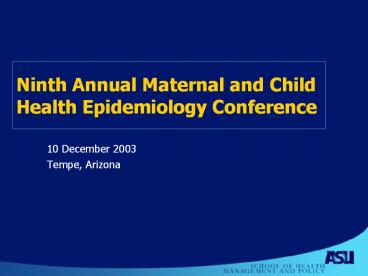Ninth Annual Maternal and Child Health Epidemiology Conference - PowerPoint PPT Presentation
1 / 24
Title:
Ninth Annual Maternal and Child Health Epidemiology Conference
Description:
Title: Yuma Project on Uninsured Children Author: triciaj Last modified by: College of Business Created Date: 1/11/2001 4:17:00 PM Document presentation format – PowerPoint PPT presentation
Number of Views:46
Avg rating:3.0/5.0
Title: Ninth Annual Maternal and Child Health Epidemiology Conference
1
Ninth Annual Maternal and Child Health
Epidemiology Conference
- 10 December 2003
- Tempe, Arizona
2
Emergency Departments as a Source of Care for
Latino Children in a Border Community
- William G. Johnson, Ph.D.
- Arizona State University
- 480-965-7442
- William.g.johnson_at_ asu.edu
- Mary E. Rimsza, M.D.
- Arizona State University
- 480-965-1622
- Mary.Rimsza_at_asu.edu
3
The Community Health Data System (CHDS) Model
- Obtain routinely collected administrative data
from employers, insurers, providers and health
related organizations - Merge across data sources to create integrated
individual records for each person - Encrypt identifiers
4
The Yuma County CHDSFlinn/ASU
- Insurance status, health care utilization and
demographic characteristics of more than 60,000
children - 1999-2002 and continuing
- Sponsors The Flinn Foundation/ASU
5
Advantages
- Information is available when questions arise
rather than a collect it when the question is
asked approach - Data available without long time lags
- More cost effective than project by project data
collection - Capture changes over time
6
Insurance Coverage Varies by Race/Ethnicity, 2001
7
Health Care Utilization 2001
8
Children See Multiple Providers2001
Outpatient
Other Providers N5,860
N16,116
N4,606
N3,388
ER
N1,588
N3,384
N124
N998
Inpatient
9
A Majority of ED Users Are Insured
10
ED Utilization by Ethnicity Insured
11
ED Utilization by Ethnicity Uninsured
12
ED Utilization for Non-Urgent Care
1999Multivariate Models
13
Characteristics That Affect Access to Health Care
14
Multivariate Results ED for Non-Urgent Care
(Pediatrics)
- Uninsured 4X Likely to use ED
- Access to pediatric care 73 less likely to use
ED if insured 93 if uninsured - Adolescents most likely age group to use ED
- Controlling for insurance coverage, Latino
children no more likely to use ED
15
Multivariate Results ED Sole Source for
Non-Urgent Care
- Uninsured 7X More Likely to use ED as sole source
- Native American children most likely ethnic group
to rely on ED - Latino children 70 less likely to rely on ED if
uninsured - Latino children not different from White
Non-Latino if insured
16
Tracking Children Over Time1999-2001
17
Health Care Utilization1999-2001
1999 2000 2001 No. of Children
X X X 13,596 24.6
X 12,442 22.5
X 7,802 14.1
X X 7,331 13.3
X 6,233 11.3
X X 5,100 9.2
X X 2,695 4.9
29,193 32,260 36,064 55,199 100
18
Insurance Patterns for Latino Children, 1999-2001
Two years interrupted 1.9
One year interrupted 8.3
Three years interrupted 0.4
Interrupted periods 10.6
Continuous Uninsured 0.3
Continuously Insured 89.20
19
Specific Conditions by Ethnicity, 1999 - 2001
Cohort
percent
20
Specific Conditions by Ethnicity, 1999 - 2001
Cohort (cont.)
percent
21
Research in Progress
22
Ongoing Research from the Yuma CHDS Data
- Air Pollution and the Incidence of Respiratory
Conditions - The Prevalence and Treatment of Asthma by
Ethnicity - Patterns of Health Insurance Coverage over Time
by Ethnicity - The Effects of Changing Insurance Coverage on
Access to Care
23
Next Steps M-HIP Project St. Lukes/ASU
- M-HIP Maricopa Health Information Project
- All residents of Maricopa County
- Operational as of July 1, 2003
- Sponsor St. Lukes Health Initiatives
- Endorsed by Arizona Medical Association
24
Additional Information
- William G. Johnson
- Professor of Economics
- School of Health Administration Policy
- W. P. Carey School of Business
- Arizona State University
- William.g.johnson_at_asu.edu
- 602-840-4293
- 480-965-7442































